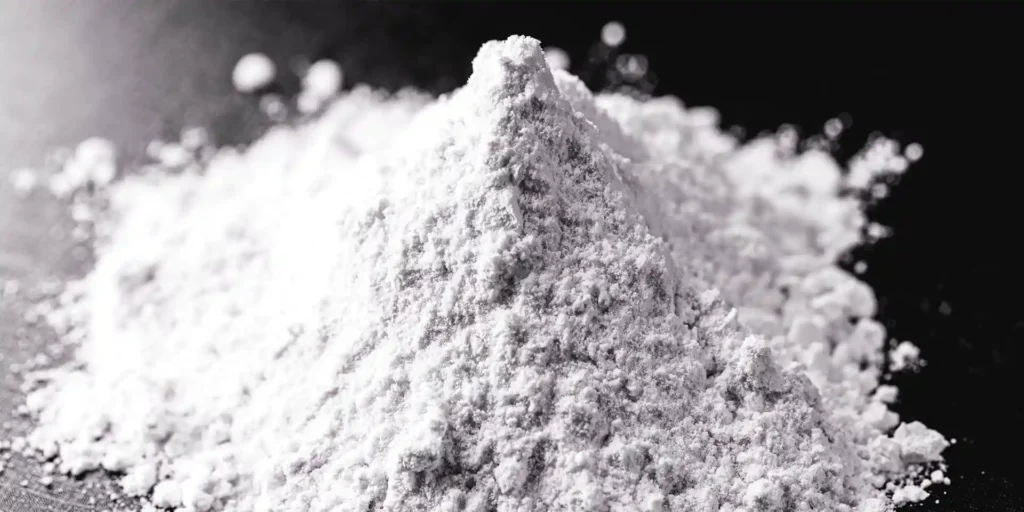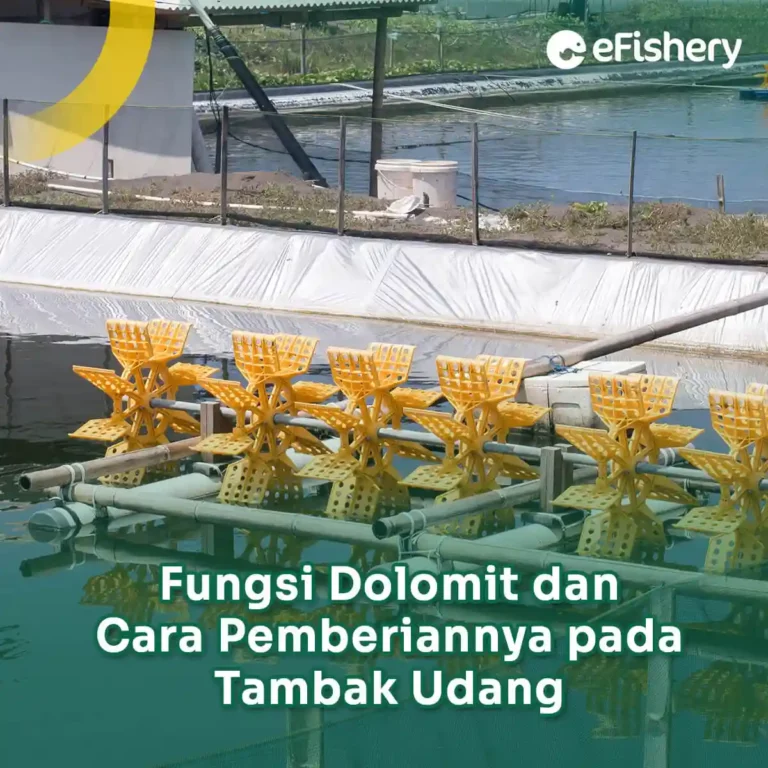Artikel Ini Telah Direview Oleh:

Nabilla Anggi
Magister Budidaya Perairan
The problem that is often experienced by novice farmers is the high mortality of shrimp caused by the molting process. One way to deal with molting is the use of dolomite. The function of dolomite in shrimp ponds is to increase alkalinity and stabilize the pH of the water in helping the shrimp molting process.
Before we discuss it further, you must first know what dolomite is. After that, we will discuss how to give it and the function of dolomite in shrimp ponds.
Get to know the Dolomites

Dolomite which is also known as calcium magnesium carbonate or CaMg(CO3)2 has a difference with agricultural lime. Dolomite is a pure element that contains high calcium and magnesium, while agricultural lime only has calcium which is used to overcome soil acidity. Dolomite is one of the materials that is very necessary for the success of aquaculture harvests, especially shrimp farming.
Dolomite is produced through a process called dolomitization with a composition similar to limestone or calcite. Applying lime to the shrimp culture media is also a solution to the problems of alkalinity, pH stability, and the decomposition of organic matter in the shrimp culture media.
Dolomite lime has high levels of magnesium and calcium which can overcome soil acidity, soil toxic substances, form soil porosity and nutrient availability. Meanwhile, agricultural lime only has calcium which is used to overcome soil acidity.
Functions of Dolomite in Shrimp Ponds
Shrimp pond water which has unstable nutrients and low alkalinity can be treated with dolomitic lime. Dolomitic limestone has several functions as follows:
- Increase pH
- Neutralizes acid
- Increase CO2 (for phytoplankton photosynthesis)
- Increase phosphorus at the bottom of the pool
- Produce macronutrients that are important in creating a favorable environment for shrimp ponds
- Activates various digestive enzymes
- Increasing and accelerating the process of molting and hardening of the carapace if the mineral needs, especially calcium (Ca), are fulfilled. The molting process which runs quickly will increase the shrimp's appetite so that it will replace the previous decreased appetite during molting
- Influence feed consumption to be optimal so as to increase the specific growth rate, increase weight, and increase shrimp biomass.
During the cultivation process, external circumstances can make the pH unstable (pH < 7.2) which could affect the macronutrient composition and micronutrients continue to decline. This can be overcome by sprinkling dolomite lime on shrimp ponds regularly. Dolomite lime has high magnesium and calcium which can overcome soil acidity, soil toxic substances, soil porosity, and the availability of nutrients for shrimp ponds.
If the dolomite sprinkling composition is correct, then the pond environment will be suitable for the growth of aquatic plankton (shrimp natural food) and pond pH stability. The presence of plankton in shrimp ponds is one of the biological indicators to evaluate the fertility characteristics of a waters.
The Right Way to Give Lime in Ponds
The use of various kinds of minerals in the feed can increase the growth of shrimp. Dolomitic lime CaMg(CO3)2 and lime oxide (CaO) is a raw material that is easy to obtain and can be used as a source of calcium and magnesium additives for shrimp feed. Giving the right dose of lime results in better molting intensity, weight growth, and daily growth of shrimp.
Here's the right way to apply lime to shrimp ponds:
1. Identification of pond size
Identify pond sizes such as area, water volume, and shrimp density to determine the amount of lime dosing. Adjust the amount of lime that is spread with changes in the pH of the shrimp pond. Use a pH meter to determine the pH of pond water, then add dolomite lime to neutralize the pH value of shrimp pond water. The ideal water pH for shrimp is around 6.5-9 with a stocking dose of 100-250 kg/ha.
2. Use of Lime Raw Materials As Needed
If there is molting of shrimp, the shrimp need minerals, especially calcium (Ca) to optimize the formation of a new carapace.
Find the Best Advice to Increase Shrimp Productivity with the Consulting Feature on eFarm!
Need Help Regarding Shrimp Cultivation Business?
Fill in your personal data in the following form. Our team will immediately contact you via the number cellphone attached. Make sure the data entered is correct.
The survival of shrimp is greatly affected by molting, where the shrimp's body is very weak. Therefore, it is important for farmers to add dolomite lime to the pond media so that the intensity of molting, growth and survival rates Shrimp can be increased.
Want to start shrimp farming but need direction? Calm down, you don't need to worry! eFarm the solution!
eFarm is a shrimp farming management application that provides various kinds of solutions for shrimp farmers in dealing with problems that often occur in pond ponds. With one click, you can learn about cultivation and get a free consultation with an expert.
What are you waiting for? Let's get optimal yields with eFarm! Have application eFarm Now!

Nabilla Anggi - Magister Budidaya Perairan
Nabilla merupakan lulusan sarjana dan magister budidaya perairan serta memiliki pengalaman di dunia perikanan baik hatchery maupun pembesaran
Questions Regarding the Function of Dolomite in Shrimp Ponds and How to Handle It
The function of dolomite in shrimp ponds is to increase pH, neutralize acid, increase CO2 (for photosynthesis phytoplankton), increases phosphorus at the bottom of the pond, and produces macronutrients that are important in creating a favorable environment for shrimp ponds.
Dolomites are given when the pH of the water is unstable (pH < 7.2) which could affect the macronutrient composition and micronutrients continue to decrease, thus making shrimp susceptible to disease.
Dolomite lime has high levels of magnesium and calcium which can overcome soil acidity, soil toxins, form soil porosity and nutrient availability, while agricultural lime only has calcium which is used to overcome soil acidity.
- Alimaturahim, Faisal Supriyono, Eddy Hastuti, Yuni Puji Nirmala, Strong. 2021. The effectiveness of dolomite administration on water quality, physiological response and growth performance of vannamei shrimp (Litopenaeus vannamei). Scientific Repository IPB University.
- Staszczuk, P and Pękalska J. 2003. Methods Of Preparation Of Magnesium Organic Compounds From Natural Dolomite. Department of Physicochemistry of Solid Surfaces,. Faculty of Chemistry. Maria Curie- Sklodowska University.
- Supono. 2018. Water Quality Management for Shrimp Farming. Bandar Lampung: AURA.
- Yunus, R., A. Haris and Hamsah. 2020. Effect of adding dolomite lime and quicklime in rearing medium on moulting, growth and survival of white shrimp (Litopenaeus vannamei). Octopus: Journal of Fisheries Science. 9(1):39-47.
